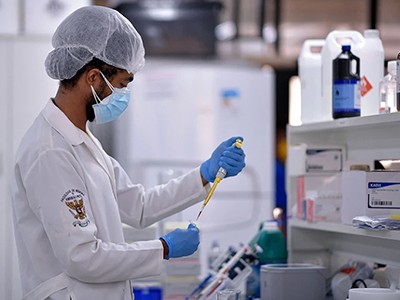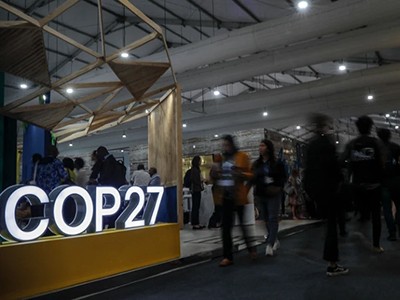
Social distancing during the COVID-19 pandemic (pictured in Singapore).Credit: Ore Huiying/Getty
At the start of this month, it looked as though talks on a pandemic agreement — designed to prevent, prepare for and improve the world’s response to an event such as the global COVID-19 outbreak — were heading for the rocks, with countries riven by deep divisions.
The world was still in a pandemic when discussions kicked off in 2021. The World Health Assembly (WHA), the decision-making body of the World Health Organization (WHO) that is akin to a parliament for the world’s health ministers, told negotiators to finalize a text by this month. The latest text, dated 10 May, that was circulated to negotiators showed that gaps are being bridged. Talks are now due to end on 24 May, just in time for the start of this year’s WHA meeting, starting on 27 May in Geneva, Switzerland.
Global ‘pandemic treaty’: nations wrestle with how to fairly share virus data
This is the right course. The world needs this treaty, without delay: there’s been no let-up in public-health threats, and the next pandemic will not respect any human timetable. But the world also needs the right treaty. As in all complex negotiations, compromise — on all sides — will be necessary to get the final version over the finishing line. But all sides must also remember that there is little point to an agreement that doesn’t improve pandemic preparedness and response — or one that ignores or undermines the principle of equity between nations.
According to the latest draft, the agreement, once finalized, would be similar to many United Nations conventions. Decisions would be made at periodic ‘conferences of the parties’, as they are at UN climate conferences, for example. The WHO would act as the secretariat, in addition to its various existing roles in global public health.
However, significant sticking points remain, among them Articles 11 and 12. Article 11 is on arrangements to transfer technology so that, during pandemics, low- and middle-income countries (LMICs) can make necessary health products, such as vaccines, drugs and testing kits, without delay. Article 12 is a proposal for a system in which countries would promptly share samples and genomic sequences of pathogens with pandemic potential — setting in stone the way in which scientific knowledge was shared during the COVID-19 pandemic. In exchange for sharing such information during emergencies, LMICs would receive some pandemic-related products at no cost or at affordable prices when a pandemic is declared.
Another proposal on the table links the issues in Articles 11 and 12 by requiring relevant technologies to be transferred during a health emergency, in exchange for prompt access to pathogen data. But these measures are opposed by countries with significant interests in pharmaceutical research and development. These countries want to mandate data sharing during a pandemic, but do not want to be compelled to share technologies that are created using those data.
The necessity of information-sharing during a public-health emergency cannot be overstated. COVID-19 was eventually controlled with vaccines in no small part because virus samples and sequencing data were shared quickly and continuously.
Global pandemic treaty: what we must learn from climate-change errors
But how the pandemic unfolded also makes a powerful case for the need to connect data-sharing to technology transfer. The Omicron variant of SARS-CoV-2, the virus that causes COVID-19, was sequenced and shared by researchers in South Africa and Botswana (R. Viana et al. Nature 603, 679–686; 2022) — and these data were used in the development of vaccines. These were the same vaccines that LMICs had to wait for until wealthier nations were supplied, sometimes with more doses than were needed. Researchers have found that more than one million lives were lost as a result of such vaccine hoarding (S. Moore et al. Nature Med. 28, 2416–2423; 2022).
The latest text of the proposed treaty shows some progress towards finding common ground. For example, Article 13 mandates that parties publish the terms of purchase agreements with companies making pandemic-related health products, ensuring pricing transparency. This did not happen during the COVID-19 pandemic. When an essential product is scarce, such as vaccines in a pandemic, and there is no pricing transparency, companies can charge what they like, with the highest bidder taking the spoils. This creates unfair competition and is the wrong thing to do when scarce resources need to be shared equitably.
At present, the text for Article 11 also proposes that “government-owned” technologies could be licensed “for the benefit of developing countries”. Often, patented health-care products are the result of close public–private partnerships, and this provision gives more weight to the idea that publicly funded technologies should be more readily available in a pandemic.
But talks on Article 12 remain deadlocked. An earlier draft attempted a compromise by saying that the WHO should be given the authority to distribute 20% of pandemic-related health products to countries most in need. More details on defining which products, and whom they must benefit, would have been finalized by May 2026 in a new and legally binding section of the agreement. But not every higher-income country was on board and the latest text indicates a lack of agreement.
No more time must be lost in finding a compromise. As WHO director-general Tedros Adhanom Ghebreyesus has said: “Give the people of the world, the people of your countries, the people you represent, a safer future. So I have one simple request: please, get this done, for them.”

 Bird flu in US cows: where will it end?
Bird flu in US cows: where will it end?
 Global ‘pandemic treaty’: nations wrestle with how to fairly share virus data
Global ‘pandemic treaty’: nations wrestle with how to fairly share virus data
 Global pandemic treaty: what we must learn from climate-change errors
Global pandemic treaty: what we must learn from climate-change errors
 Unseating big pharma: the radical plan for vaccine equity
Unseating big pharma: the radical plan for vaccine equity






